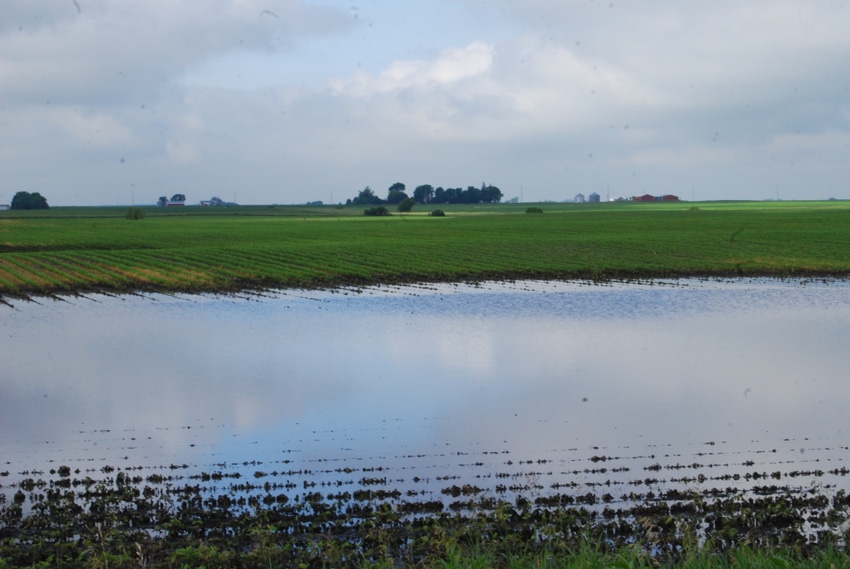
Iowa continues to have lofty crop ratings, according to USDA’s latest weekly survey. The state’s corn crop is rated 81% good-to-excellent, and 79% of the soybeans are in that category for the week ending June 24. But heavy rainfall has left fields ponded and caused flooding in some northern counties, especially in northwest and north-central Iowa.
With above-normal rainfall, topsoil moisture conditions have improved in south-central Iowa, which previously has been dry this season. That area of the state is now rated 66% adequate to surplus for topsoil moisture — the highest percentage in those categories in over a year for the south-central crop reporting district.
Yield losses anticipated in northern Iowa
April snowstorms and May showers delayed planting. June downpours continue to hamper spraying and may cause crop disease problems. Chuck White, farming near Spencer in northwest Iowa, says 30 inches of snow in April and 6 inches of rain in May kept crops from getting planted in a timely manner. Heavy rainfall in June is making it hard to sidedress corn and spray weeds.
“It’s been a tough go, but crops are hanging in there so far—except for the flooded fields. The additional rain this past week and now this week is a concern,” he notes. “We are dealing with ponding, nitrogen loss, and I’m afraid some weeds may get too tall to spray and weed escapes could occur.”
Storms continue to bring heavy rain
“The storms that have rolled across Iowa over the past couple of weeks have brought needed moisture to some areas, but unfortunately, we’ve also seen significant flooding in other parts of the state,” says Iowa Secretary of Agriculture Mike Naig. “Many areas could use a few days of dry weather to allow fields to dry out so farmers can spray and have a chance to make hay.”
The complete weekly Iowa Crop Progress & Weather Report is available on the Iowa Department of Ag & Land Stewardship website iowaagriculture.gov or on USDA’s site nass.usda.gov/ia. The report summary follows.
Crop report
Another week of storms, which delivered heavy rainfall across much of Iowa resulted in just 2.1 days suitable for fieldwork during the week ending June 24, according to USDA’s National Ag Statistics Service. Activities for the week included checking rain gauges, assessing flood damage, harvesting hay and applying postemergent herbicides when weather permitted.
Topsoil moisture averaged 1% very short, 6% short, 68% adequate and 25% surplus. Subsoil moisture rated three% very short, 10% short, 67% adequate and 20% surplus. Heavy rain left many fields ponded and caused flooding in some northern counties. In south-central Iowa, topsoil moisture supplies rated 66% adequate to surplus — the highest percentage in these categories since the week ending June 4, 2017.
Iowa corn 81% good-to-excellent
Iowa’s corn crop is rated 81% in good-to-excellent condition. Nearly all the soybean crop has emerged with 4% of the crop blooming, three days ahead of both last year and the five-year average. Iowa’s soybean crop is rated 79% in good-to-excellent condition. The weekly survey showed 84% of the oat crop has headed, three days ahead of average, and 80% of the oat crop is in good-to-excellent condition.
With the first cutting of alfalfa hay nearing completion, the second cutting reached 8% complete. Putting up hay was a challenge last week due to persistent rainfall. Hay condition rated 73% good-to-excellent. Pasture conditions rated 67% good-to-excellent. Heat and high humidity continued to stress livestock. Muddy conditions are making feedlot operations difficult.
Weather summary
According to Justin Glisan, IDALS climatologist, Iowa experienced a pronounced pattern shift from previous weeks that brought measurable precipitation to the state during the week ending June 24. This active pattern produced both flash and short-term flooding across northwest and western Iowa.
On June 18, the week began with a stationary boundary situated over northwest Iowa, which fired up storms in the early morning and late afternoon hours. Council Bluffs recorded 5.52 inches of rain on June 19, as thunderstorms moved through southern Iowa.
Heavy rain, flooding
A low-pressure system moved in on June 20, bringing heavy rain to Iowa’s northwest corner; flood warnings were issued in multiple counties, including Clay, Dickinson and Osceola. As the day progressed, a line of severe thunderstorms formed in central Iowa and raced toward the north and east. There were multiple reports of severe winds, hail and weak tornadoes, with Perry and Scranton observing snapped and uprooted trees.
On June 21, flood warnings encompassed six counties in the northwest as the low-pressure system moved south. Isolated thunderstorms popped up in central Iowa that evening. June 22-23 saw relatively quiet conditions across the state, while thunderstorms (some severe) returned on June 24 to central Iowa to end the week. A slow-moving line stretched from Centerville in southern Iowa all the way to Le Mars in northwest Iowa, bringing rain accumulations of up to 2 inches near Sioux City.
Temps as high as 98
For temperature, the week began with highs averaging 4 to 8 degrees F above normal. Donnellson, in Lee County in Iowa’s southeast corner, observed highs of 96 degrees on June 18 and 98 degrees June 19, almost 14 degrees above normal.
Midweek saw temperatures fall below normal, with average departures up to 8 degrees in northern and western Iowa. Sioux Center in Sioux County had a high of 65 degrees on June 21, which was almost 20 degrees below normal. The week ended unseasonably cool with average highs 10 to 12 degrees below normal in Iowa’s southern third; statewide average temperatures were in the low 70s.
About the Author(s)
You May Also Like




